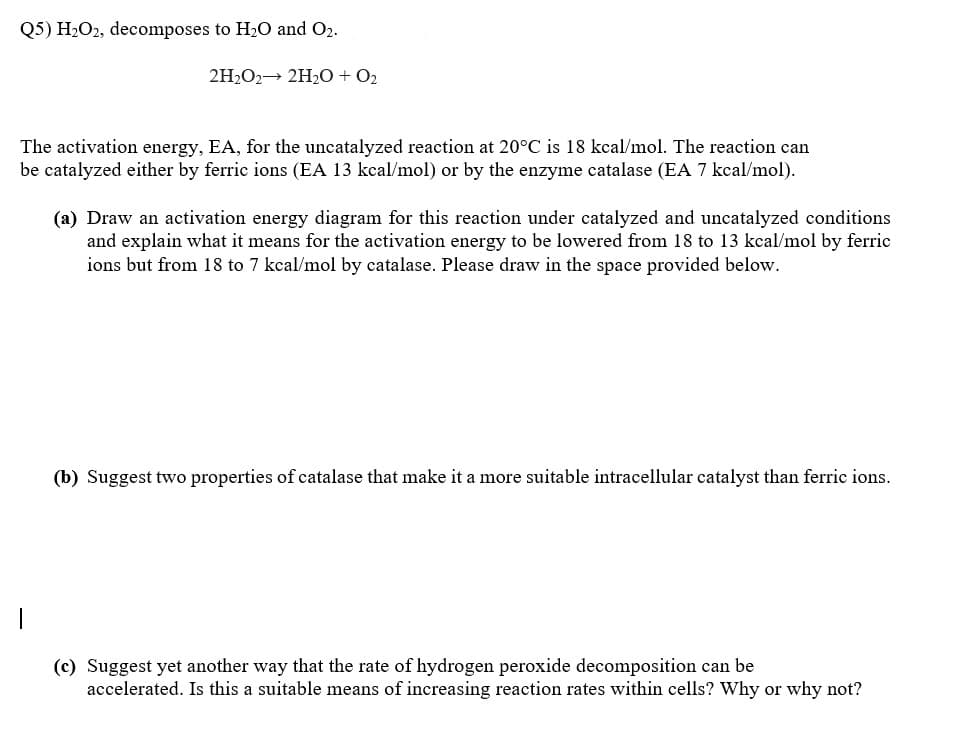(a) Draw an activation energy diagram for this reaction under catalyzed and uncatalyzed conditions and explain what it means for the activation energy to be lowered from 18 to 13 kcal/mol by ferric ions but from 18 to 7 kcal/mol by catalase. Please draw in the space provided below. (b) Suggest two properties of catalase that make it a more suitable intracellular catalyst than ferric ions.
(a) Draw an activation energy diagram for this reaction under catalyzed and uncatalyzed conditions and explain what it means for the activation energy to be lowered from 18 to 13 kcal/mol by ferric ions but from 18 to 7 kcal/mol by catalase. Please draw in the space provided below. (b) Suggest two properties of catalase that make it a more suitable intracellular catalyst than ferric ions.
Human Anatomy & Physiology (11th Edition)
11th Edition
ISBN:9780134580999
Author:Elaine N. Marieb, Katja N. Hoehn
Publisher:Elaine N. Marieb, Katja N. Hoehn
Chapter1: The Human Body: An Orientation
Section: Chapter Questions
Problem 1RQ: The correct sequence of levels forming the structural hierarchy is A. (a) organ, organ system,...
Related questions
Question
pls help

Transcribed Image Text:Q5) H2O2, decomposes to H2O and O2.
2H,O2→ 2H20 + O2
The activation energy, EA, for the uncatalyzed reaction at 20°C is 18 kcal/mol. The reaction can
be catalyzed either by ferric ions (EA 13 kcal/mol) or by the enzyme catalase (EA 7 kcal/mol).
(a) Draw an activation energy diagram for this reaction under catalyzed and uncatalyzed conditions
and explain what it means for the activation energy to be lowered from 18 to 13 kcal/mol by ferric
ions but from 18 to 7 kcal/mol by catalase. Please draw in the space provided below.
(b) Suggest two properties of catalase that make it a more suitable intracellular catalyst than ferric ions.
(c) Suggest yet another way that the rate of hydrogen peroxide decomposition can be
accelerated. Is this a suitable means of increasing reaction rates within cells? Why or why not?
Expert Solution
This question has been solved!
Explore an expertly crafted, step-by-step solution for a thorough understanding of key concepts.
This is a popular solution!
Trending now
This is a popular solution!
Step by step
Solved in 3 steps with 1 images

Recommended textbooks for you

Human Anatomy & Physiology (11th Edition)
Biology
ISBN:
9780134580999
Author:
Elaine N. Marieb, Katja N. Hoehn
Publisher:
PEARSON

Biology 2e
Biology
ISBN:
9781947172517
Author:
Matthew Douglas, Jung Choi, Mary Ann Clark
Publisher:
OpenStax

Anatomy & Physiology
Biology
ISBN:
9781259398629
Author:
McKinley, Michael P., O'loughlin, Valerie Dean, Bidle, Theresa Stouter
Publisher:
Mcgraw Hill Education,

Human Anatomy & Physiology (11th Edition)
Biology
ISBN:
9780134580999
Author:
Elaine N. Marieb, Katja N. Hoehn
Publisher:
PEARSON

Biology 2e
Biology
ISBN:
9781947172517
Author:
Matthew Douglas, Jung Choi, Mary Ann Clark
Publisher:
OpenStax

Anatomy & Physiology
Biology
ISBN:
9781259398629
Author:
McKinley, Michael P., O'loughlin, Valerie Dean, Bidle, Theresa Stouter
Publisher:
Mcgraw Hill Education,

Molecular Biology of the Cell (Sixth Edition)
Biology
ISBN:
9780815344322
Author:
Bruce Alberts, Alexander D. Johnson, Julian Lewis, David Morgan, Martin Raff, Keith Roberts, Peter Walter
Publisher:
W. W. Norton & Company

Laboratory Manual For Human Anatomy & Physiology
Biology
ISBN:
9781260159363
Author:
Martin, Terry R., Prentice-craver, Cynthia
Publisher:
McGraw-Hill Publishing Co.

Inquiry Into Life (16th Edition)
Biology
ISBN:
9781260231700
Author:
Sylvia S. Mader, Michael Windelspecht
Publisher:
McGraw Hill Education